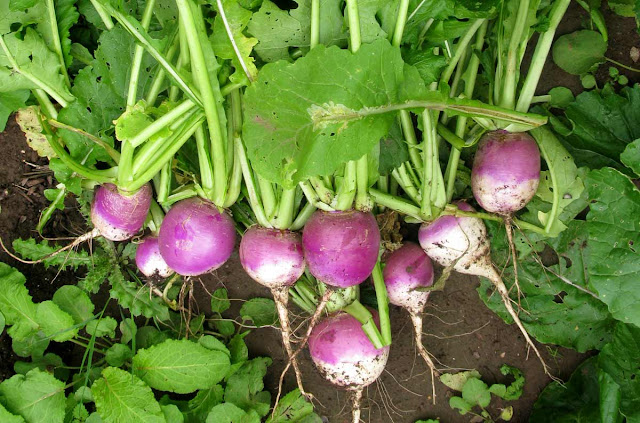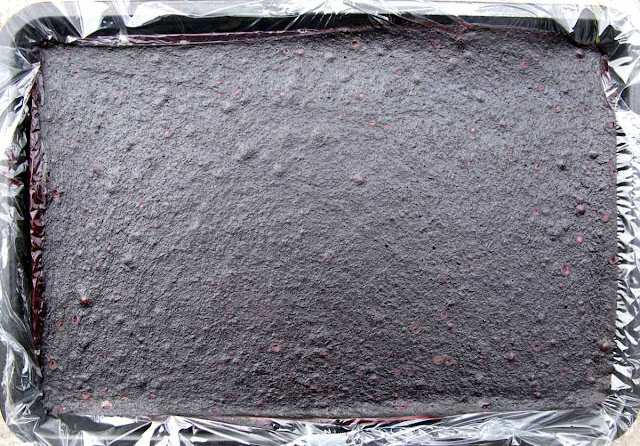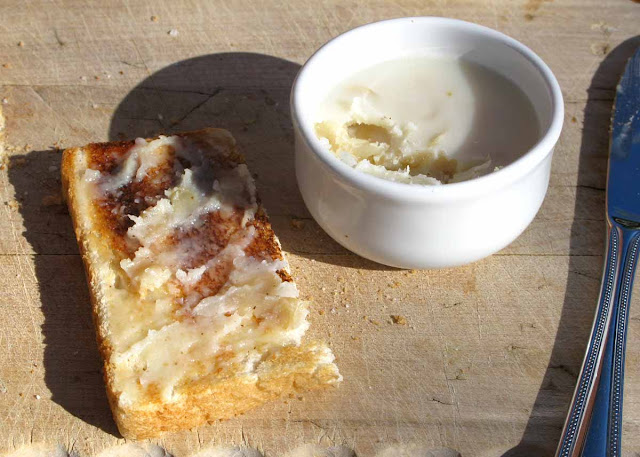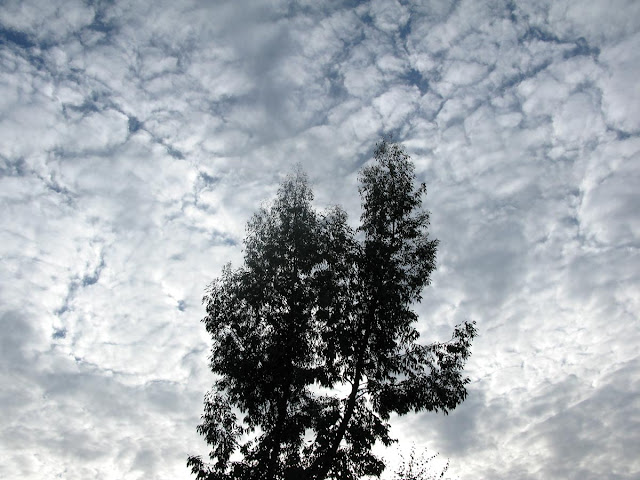21 Jul 2011
Primrose Farm
This organic farm in the Black Mountains, in Wales, is described as "in all probability the most productive piece of agricultural land in Britain, maybe in Europe"; producing, in a sustainable way, around £25,000 worth of a great variety of produce on one and a half acres.
The Primrose Farm website: www.primroseearthcentre.co.uk
13 May 2011
How to make bresaola
Home-cured meat.
This is a Guardian article giving instructions on how to cure and make air-dried beef.
This is a Guardian article giving instructions on how to cure and make air-dried beef.
10 May 2011
A problem with a mole
I sat on the clematis bench in the veg garden the other day, sunbathing, reading and smoking. My eyes were taken by something moving under the soil, causing the surface to crack. I was fascinated by this for about an hour as the cracks moved about across the garden, under the planted rows, loosening seedlings and lifting some right out.
This is causing a serious nuisance. I looked up moletraps; found some that kill, which I don't want to do; and some which catch the mole in a tube inserted into the mole's tunnel. The mole is then transferred somewhere else. However, though this catcher initially sounds like a good, humane idea, further research reveals that it isn't necessarily so. A lot of distress is caused to the trapped mole; possibly thirst and starvation if it's not released soon enough, and it might face a territorial fight when it's released on another mole's turf.
Right now, I'm trying a battery-operated deterrent which pushes into the ground and vibrates every thirty seconds, annoying moles. I've also found a site recommending Jeye's Fluid, a disinfectant that I've long used and respected. A solution of 1:20 Jeye's Fluid to water is poured down the highest hole. This is kept up for 10 days. The moles have a highly-developed sense of smell and are discouraged by the disinfectant. A barrier to drive the moles away in the desired direction can be made by pouring a 1:40 solution across the area.
This site tells all about it: Garden Advice.
This is causing a serious nuisance. I looked up moletraps; found some that kill, which I don't want to do; and some which catch the mole in a tube inserted into the mole's tunnel. The mole is then transferred somewhere else. However, though this catcher initially sounds like a good, humane idea, further research reveals that it isn't necessarily so. A lot of distress is caused to the trapped mole; possibly thirst and starvation if it's not released soon enough, and it might face a territorial fight when it's released on another mole's turf.
Right now, I'm trying a battery-operated deterrent which pushes into the ground and vibrates every thirty seconds, annoying moles. I've also found a site recommending Jeye's Fluid, a disinfectant that I've long used and respected. A solution of 1:20 Jeye's Fluid to water is poured down the highest hole. This is kept up for 10 days. The moles have a highly-developed sense of smell and are discouraged by the disinfectant. A barrier to drive the moles away in the desired direction can be made by pouring a 1:40 solution across the area.
This site tells all about it: Garden Advice.
25 Mar 2011
Living off the land in Wales
Eco-homes: Living the good life video
A nice video from the Guardian, about people living sustainably in Wales in homes they built themselves for £3,000.
Lammas: The eco-village that lives off the grid video
Lammas, a community of nine families in Pembrokeshire, completely independent of all main services, and sourcing food, water, fuel and electricity from the site.
Lammas Eco Village website
A nice video from the Guardian, about people living sustainably in Wales in homes they built themselves for £3,000.
Lammas: The eco-village that lives off the grid video
Lammas, a community of nine families in Pembrokeshire, completely independent of all main services, and sourcing food, water, fuel and electricity from the site.
Lammas Eco Village website
12 Dec 2010
23 Oct 2010
Making paper. Part 2
These are some papers made in previous years.
These papers include bits of moss. I thought about sending some sheets of this to Kate Moss. The one on the right includes moss and onion skin. I thought about sending some sheets of this to Kate Moss for when she writes to someone who has upset her.
These papers have all sorts of bits of paper, grass, moss, reed, onion skin in them. The dark paper is made by including pulped black serviettes in the mix.
This paper has chopped reeds in it.
I typeset the names of all the characters in Shakespeare's plays, laser-printed them out on black paper and applied gold foil to them. I ripped the sheets of names into small pieces and incorporated them into the paper.
This was an experiment in which, in the winter of 2000, I went to Stratford-upon-Avon and shot photos of the river. My intention was to digitally adjust these images and print them using foil inks with a silver printed under the colours of the water.
In addition, I removed the black in the photos so that the colour and texture of a handmade paper would show through. The papermaking experiments were towards creating a paper made from, or including, reeds from the river Avon.
Other work came in and I left that project. The foil ink printer is still unused. I did, however, finish the images by using a scan of black handmade paper and printing the images without the silver underprint. They can be seen in the effervescence gallery at imagekind.com.
Making paper. Part 1
These papers include bits of moss. I thought about sending some sheets of this to Kate Moss. The one on the right includes moss and onion skin. I thought about sending some sheets of this to Kate Moss for when she writes to someone who has upset her.
These papers have all sorts of bits of paper, grass, moss, reed, onion skin in them. The dark paper is made by including pulped black serviettes in the mix.
This paper has chopped reeds in it.
I typeset the names of all the characters in Shakespeare's plays, laser-printed them out on black paper and applied gold foil to them. I ripped the sheets of names into small pieces and incorporated them into the paper.
This was an experiment in which, in the winter of 2000, I went to Stratford-upon-Avon and shot photos of the river. My intention was to digitally adjust these images and print them using foil inks with a silver printed under the colours of the water.
In addition, I removed the black in the photos so that the colour and texture of a handmade paper would show through. The papermaking experiments were towards creating a paper made from, or including, reeds from the river Avon.
Other work came in and I left that project. The foil ink printer is still unused. I did, however, finish the images by using a scan of black handmade paper and printing the images without the silver underprint. They can be seen in the effervescence gallery at imagekind.com.
Making paper. Part 1
22 Oct 2010
Making paper. Part 1
This is a very enjoyable, deeply satisfying, thing to do.
The satisfaction in it arises when you lift the mould out of the chaotic maelstrom of papermaking pieces and particles in the water. The water runs through the mesh and the particles settle flat, sucked down as the water runs through. All that chaos becomes a settled, fixed, unique creation.
Strictly, this is recycled paper. Rip up some ordinary paper into small squares. We used the sheets discarded from our inkjet printer over time. Cover with water and leave to soak overnight. Then run the soaked paper pieces through a blender to make a pulp.
Separately soak each of the other ingredients you will include in your paper. These might be: coloured paper, tissues, pictures or words on small pieces of paper, pieces of dried grass, dried leaves, whatever. (You may or may not wish to run these other ingredients through a blender; it depends how big you want them to be, and how much blended into the paper.)
Drop a few handfuls of the paper pulp into a tub of water along with any other ingredients you wish to appear in the finished paper. We used pieces torn from a colour magazine.
For this next stage you need a frame with gauze stretched over and fixed, called the mould, and a frame the same size with no gauze (this is called the deckle). You can buy these (here) or make your own mould and deckle using two empty picture frames.
Bought moulds and deckles: one mould fixed with gauze, the other with perforated zinc.
Stir up the pulp and water mixture. Holding the frame and deckle together, plunge them into the mixture and bring them up horizontal, letting the water run through, and leaving a layer of pulp on top of the gauze.
Lifting out the mould and deckle with a layer of pulp on it.
Lift off the deckle. Turn over the frame with the pulp on it and lay it on top of a wet cloth (we used J-cloths) - this is called the couching cloth.
Lifting off the deckle.
Laying the pulp and mould down on the cloths.
Press a little and lift slowly from one edge, leaving the pulp behind on top of the cloth. Cover this with another wet cloth ready for the next layer of pulp from the mould. Continue like this.
Lightly press the pulp onto the cloths.
Lift the mould away.
Press the pile of cloths and pulp layers to squeeze the water out.
We pressed the paper under a pile of bricks..
Remove the pile of cloths and paper pulp from the press and hang to dry.
Peel paper from cloth when dry.
Three sheets of finished paper.

 Scented Herb Papers: How to Use Natural Scents and Colours in Hand-Made Recycled and Plant Papers.
Scented Herb Papers: How to Use Natural Scents and Colours in Hand-Made Recycled and Plant Papers.
This is a delightful papermaking book which, in addition to colour photos of everything and good simple papermaking instructions, tells you how to scent and colour your paper and make useful items from it. The methods described in the book are pretty much the same as we used in Making paper, Part 1, but with more detail given about each stage.
Making paper. Part 2
The satisfaction in it arises when you lift the mould out of the chaotic maelstrom of papermaking pieces and particles in the water. The water runs through the mesh and the particles settle flat, sucked down as the water runs through. All that chaos becomes a settled, fixed, unique creation.
Strictly, this is recycled paper. Rip up some ordinary paper into small squares. We used the sheets discarded from our inkjet printer over time. Cover with water and leave to soak overnight. Then run the soaked paper pieces through a blender to make a pulp.
Separately soak each of the other ingredients you will include in your paper. These might be: coloured paper, tissues, pictures or words on small pieces of paper, pieces of dried grass, dried leaves, whatever. (You may or may not wish to run these other ingredients through a blender; it depends how big you want them to be, and how much blended into the paper.)
Drop a few handfuls of the paper pulp into a tub of water along with any other ingredients you wish to appear in the finished paper. We used pieces torn from a colour magazine.
For this next stage you need a frame with gauze stretched over and fixed, called the mould, and a frame the same size with no gauze (this is called the deckle). You can buy these (here) or make your own mould and deckle using two empty picture frames.
Bought moulds and deckles: one mould fixed with gauze, the other with perforated zinc.
Stir up the pulp and water mixture. Holding the frame and deckle together, plunge them into the mixture and bring them up horizontal, letting the water run through, and leaving a layer of pulp on top of the gauze.
Lifting out the mould and deckle with a layer of pulp on it.
Lift off the deckle. Turn over the frame with the pulp on it and lay it on top of a wet cloth (we used J-cloths) - this is called the couching cloth.
Lifting off the deckle.
Laying the pulp and mould down on the cloths.
Press a little and lift slowly from one edge, leaving the pulp behind on top of the cloth. Cover this with another wet cloth ready for the next layer of pulp from the mould. Continue like this.
Lightly press the pulp onto the cloths.
Lift the mould away.
Press the pile of cloths and pulp layers to squeeze the water out.
We pressed the paper under a pile of bricks..
Remove the pile of cloths and paper pulp from the press and hang to dry.
Peel paper from cloth when dry.
Three sheets of finished paper.

This is a delightful papermaking book which, in addition to colour photos of everything and good simple papermaking instructions, tells you how to scent and colour your paper and make useful items from it. The methods described in the book are pretty much the same as we used in Making paper, Part 1, but with more detail given about each stage.
Making paper. Part 2
9 Oct 2010
Valerian
Two squirrels in the head disorder
As the physician states, valerian relaxes without the side effects of most drugs used to produce the same result. It won't make you feel drowsy or drugged. The muscles and the mind are just relaxed. There is a condition I call "two squirrels in the head disorder". One of its symptoms is that your mind starts racing nonstop from one stressful thought to the next when all you really want to do is fall asleep. It's like having two squirrels in your head chasing each other's tails.
Of course, this usually happens when you have something going on the next morning that is killer important, some sort of activity that required your being at your best. The more you can't sleep, the more you check the clock to see how much sleep you haven't had thus far. At this junction, if you hop out of bed and make yourself a cup of hot valerian tea, the squirrels will move on, and your mind will slow down enough for you to fall to sleep. If you are in the middle of a stressful period, three cups a day or one cup right before bedtime will help you through.

Herbalism can be confusing at first because many herbs have a range of beneficial ingredients, some of which can often be found in other herbs. But this book focuses on one common herb for each ailment, and gives an interesting discussion of it, with history, use and preparation.
Valerian flowers: The scent from valerian flowers is delightful, like a mild jasmine, and faintly musky. In the summer, as we walked past the plant, with its flowers at the top of eight-foot stalks, we wondered where the strangely pleasant smell was coming from.
Valerian flowers are said to be good for cutting and displaying in the house where they add their delightful scent.
Valerian root: This is the part of the plant used to make valerian tea.
Valerian root washed.
Valerian root dried.
Valerian hot chocolate
There's a delicious-sounding recipe for valerian hot chocolate in James Wong's Grow Your Own Drugs
.
To make 3 cups requires:
3 tbsp fresh valerian root
3 tbsp fresh lemon balm leaves
3 tsp fresh lavender leaves
6 leaves and 3 heads from fresh passion flowers
peel of 1.1/2 oranges
900 ml full-fat milk
50g dark chocolate (min 50% cocoa solids)
dash of vanilla extract
1. Chop the top and bottom from the fresh valerian root. Add the valerian, lemon balm, lavender, passion flowers, orange peel and milk to a pan and gently heat for 5-10 minutes. Strain.
2. Pour the infused milk back into the pan, then add the dark chocolate and vanilla extract and stir until melted. Drink at once.
3 Oct 2010
We are stardust
In 1957, Hoyle and Fowler showed that all the elements from which our world is made – from carbon atoms to uranium atoms – had been cooked inside stars eons ago from a basic fuel of hydrogen. These heavy elements were then blasted into space in great stellar explosions called supernovae, where they later congealed into planets, mountains – and humans. We are stardust, in other words. (Source)
Joni Mitchell:
We are stardustHere's a video of Joni Mitchell singing We Are Stardust at Woodstock, California, 1969.
We are golden
And we've got to get ourselves
Back to the garden.
---------------------------------------------------------------------------------------------------------------------------
[The unretouched photo of the full moon, above, taken on 24th July 2010, shows a green object which appears to be a planet. It is, I believe, just lens flare. (Click photo to enlarge)]
30 Sept 2010
Turnips
We had two packets of turnip seed in our collection, so we put them in to use them up.
Unfortunately, they're not very popular here: we tried them boiled and roasted, but they still didn't justify their place in the garden.
Yet, before now, I've bought a pound of small ones and eaten them like apples, and enjoyed them. But the ones we've grown now have a bit too much of that radish heat about them.
All's not lost, though. It happened that a duck left six ducklings behind (story here), and they have enjoyed the turnips, the tops particularly.
I think my urge to eat them like apples and to grow them was probably romantic. For many years now I have enjoyed the novels of Erskine Caldwell (the cheap-looking paperbacks you used to see on second-hand bookstalls).
In Tobacco Road , he writes of Jeeter Lester, the father in a poor family of sharecroppers in the US south of the 30s, and his enjoyment of raw turnips.
, he writes of Jeeter Lester, the father in a poor family of sharecroppers in the US south of the 30s, and his enjoyment of raw turnips.
A hungry Jeeter is trying to con a visitor to the house out of his sack of turnips:
Caldwell's biographer writes that Erskine's father, a minister, was described to the son by his mother as "'a noble warrior of the truth' - a man who stood up against the small-mindedness, bigotry and cruelty he found in the small towns of his native region. As an adult, Erskine would make his father's causes his own, and in his writing he sought to honour and vindicate him.")
writes that Erskine's father, a minister, was described to the son by his mother as "'a noble warrior of the truth' - a man who stood up against the small-mindedness, bigotry and cruelty he found in the small towns of his native region. As an adult, Erskine would make his father's causes his own, and in his writing he sought to honour and vindicate him.")
Unfortunately, they're not very popular here: we tried them boiled and roasted, but they still didn't justify their place in the garden.
Yet, before now, I've bought a pound of small ones and eaten them like apples, and enjoyed them. But the ones we've grown now have a bit too much of that radish heat about them.
All's not lost, though. It happened that a duck left six ducklings behind (story here), and they have enjoyed the turnips, the tops particularly.
I think my urge to eat them like apples and to grow them was probably romantic. For many years now I have enjoyed the novels of Erskine Caldwell (the cheap-looking paperbacks you used to see on second-hand bookstalls).
In Tobacco Road
A hungry Jeeter is trying to con a visitor to the house out of his sack of turnips:
"I got a powerful gnawing in my belly for turnips. I reckon I like winter turnips just about as bad as a nigger likes watermelons. I can't see no difference between the two ways. Turnips is about the best eating I know about."(Anyone feeling that Caldwell's use of the word 'nigger' is derogatory should understand that he uses the speech of the people of that day. Caldwell himself was against discrimination and denigration of all poor, black and white, and many Southerners reviled him for his brutal exposés of their region.
Caldwell's biographer
29 Sept 2010
Fruit leather
Damson, apple, grape and fennel fruit leather.
This year, instead of simply drying the damsons as we did last year (see here), we made fruit leather - from damsons and from various combinations.
To make fruit leather, remove all stones, peel and core apples, then put the fruit into a blender and blend until it's as fine as you want it. Pour out onto an oven tray covered with clingfilm a 1/8" to 1/4" layer of the fruit pulp. (Be sure that all stones are removed. If you leave one it will be chopped in the blender into hard, sharp little pieces.)
Place in an oven on very low, about plate-warming temperature, and leave for 24 hours. Peel the drying pulp off the clingfilm and turn it over. Leave for another 12 hours.
Roll it up in the clingfilm and store in the fridge or freezer -
Varying the ingredients -
Apple, banana, honey and toasted oats.
Damson and liquorice, poured after blending soft liquorice and damsons.
Damson and liquorice dried.
Damson and liquorice cut with scissors into strips for eating.
There's more info on fruit leathers and a table of the suitability of various fruits here.
This year, instead of simply drying the damsons as we did last year (see here), we made fruit leather - from damsons and from various combinations.
To make fruit leather, remove all stones, peel and core apples, then put the fruit into a blender and blend until it's as fine as you want it. Pour out onto an oven tray covered with clingfilm a 1/8" to 1/4" layer of the fruit pulp. (Be sure that all stones are removed. If you leave one it will be chopped in the blender into hard, sharp little pieces.)
Place in an oven on very low, about plate-warming temperature, and leave for 24 hours. Peel the drying pulp off the clingfilm and turn it over. Leave for another 12 hours.
Roll it up in the clingfilm and store in the fridge or freezer -
Varying the ingredients -
Apple, banana, honey and toasted oats.
Damson and liquorice, poured after blending soft liquorice and damsons.
Damson and liquorice dried.
Damson and liquorice cut with scissors into strips for eating.
There's more info on fruit leathers and a table of the suitability of various fruits here.
28 Sept 2010
Garlic in goose fat
We had a good crop of garlic this year, from which we made garlic in goose fat.
This is simply peeled garlic cloves simmered until soft in goose fat.
The cooked cloves are taken out of the fat and placed in a jar, with goose fat added to cover them.
Great winter food, spread on toast, with a sprinkle of salt.
This is simply peeled garlic cloves simmered until soft in goose fat.
The cooked cloves are taken out of the fat and placed in a jar, with goose fat added to cover them.
Great winter food, spread on toast, with a sprinkle of salt.
19 Sept 2010
Subscribe to:
Posts (Atom)


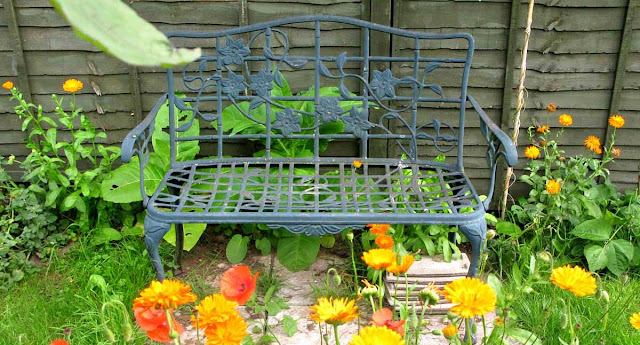









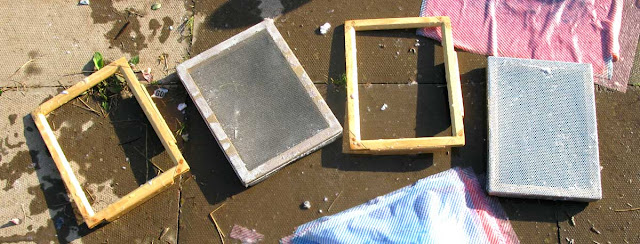












byWong](http://ws.amazon.com/widgets/q?MarketPlace=US&ServiceVersion=20070822&ID=AsinImage&WS=1&Format=_SL160_&ASIN=B003ZTPP3A&tag=pheasa-20)


